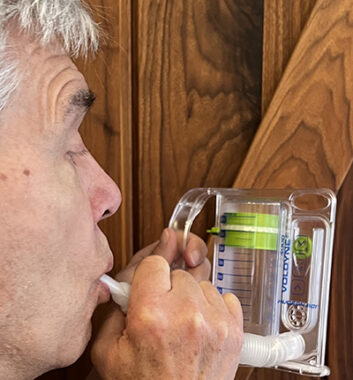How I proactively work to maintain my lung health with Fabry disease
A columnist shares the tips and tools he's learned over the years
Written by |

For several years before I had a heart transplant in September 2020, I’d become progressively weaker, more fatigued, and out of breath. Like many others with Fabry disease, I had heart, kidney, and lung disease, and I’d lived an increasingly sedentary lifestyle for several years. As my health worsened, it was hard to determine how much each major organ contributed to my decline.
The extent of my lung function’s decline wasn’t apparent until I began the Army’s medical retirement process in 2007. The Army pulmonologist I visited performed a a spirometry exam — a common lung function test — at periodic intervals. The doctor focused on a specific lung function measure: forced expiratory volume in the first second, or FEV1. My first FEV1 score was 67%, compared with a normal FEV1 lung function of 80% or higher.
I was prescribed an oral medication and an inhaler to stabilize and hopefully improve those numbers. In addition, I was receiving biweekly enzyme replacement therapy (ERT), one of the Fabry disease-specific treatments approved by the U.S. Food and Drug Administration.
Even though ERT slowed my symptom progression, Fabry disease remains progressive, and my lung function continued to decline for the next 13 years, to below 50%. It was odd, though, that my blood oxygen levels during most of those clinic visits were between 98% and 100%. Based on that, I learned that blood oxygen levels measured during clinic appointments might not be reliable indicators of declining lung function.
Tips and tools

Jerry Walter uses a spirometer device at home. (Courtesy of Jerry Walter)
In addition to oral medication, the inhaler, and ERT, I enrolled in a nine-week pulmonary rehabilitation program administered by Duke University Medical Center several years ago. I attended two-hour medically supervised sessions twice a week. During them, I learned about diaphragmatic breathing, which I frequently use to keep my lungs healthier and experience other health benefits, including relaxation and stress relief. I prefer the well-known 4-7-8 breathing technique.
Many available resources describe the health benefits of diaphragmatic breathing and improving lung function, including 4-7-8 breathing. Not all of them highlight this tip, though: It’s important to exhale through pursed lips, which means puckering your lips as if you were going to whistle or blow out a candle.
Another tool I frequently use at home to maintain good lung function is a spirometer, which is a handheld breathing exercise device. It’s often sent home with someone who’s had anesthesia to help the lungs recover. I have a spirometer from my last surgery, but it can be purchased from most pharmacies or Amazon.
The American Lung Association published an article titled “10 Simple Steps to Your Healthiest Lungs,” which contains more helpful tips. I believe in being proactive about maintaining all aspects of my health, so I added this resource to my previous collection of ways I stay healthy.
According to a 2018 study published in the journal Molecular Genetics and Metabolism, lung function tests for adults with Fabry disease should be performed every two years. My next test is scheduled for August.
Lastly, a webinar about pulmonary manifestations of Fabry disease by pulmonologist Gwen Skloot is available on the National Fabry Disease Foundation’s YouTube channel.
My lung health is better now than it’s been in many years. I hope what I’ve learned is useful to others with this disease. If it is, please let me know in the comments below.
Note: Fabry Disease News is strictly a news and information website about the disease. It does not provide medical advice, diagnosis, or treatment. This content is not intended to be a substitute for professional medical advice, diagnosis, or treatment. Always seek the advice of your physician or other qualified health provider with any questions you may have regarding a medical condition. Never disregard professional medical advice or delay in seeking it because of something you have read on this website. The opinions expressed in this column are not those of Fabry Disease News or its parent company, Bionews, and are intended to spark discussion about issues pertaining to Fabry disease.







Steven Metheny
Thank you for this writing and sharing your journey. Thank you for sharing about diaphragmatic breathing, the YouTube channel, and using the spirometer.